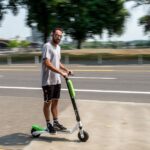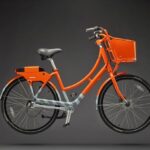Early data gives insight into usage patterns.
Portlanders have voiced plenty of opinions one month into the city’s e-scooter pilot program. But one question looms: how have the scooters impacted the city’s other alternative transportation mode, Nike Biketown?
Biketown, the city’s bikeshare system, and the dockless e-scooter companies, Lime, Bird and Skip, meet similar needs. Both systems serve as last-mile connections to and from transit stations. They provide a means for short trips in combination with other transportation modes.
Given the similarities, are the scooter invaders supplanting Biketown, or allying with the existing system to fight automobile dependency?
 The Biketown station near Pioneer Square. Caleb Diehl
The Biketown station near Pioneer Square. Caleb Diehl
Sy Adler, a professor of urban planning at Portland State University, says the latter is more likely.
“I suspect that, at least for the next few years, that the availability of both bikes and scooters is likely to increase the total amount of travel by alternative modes,” Adler wrote in an email, “rather than produce a substitution of one for the other.”
Number of vehicles
Scooters: 2,049
Biketown bikes: 1,000
Trips in a month (approximate)
Scooters (July 26 to August 30): 178,233
Biketown (typical peak summer month): 55,000
Average trip length
Scooters: 1.4 miles (around 10-15 minutes)
Biketown: 25 minutes
That could be because Biketown and scooters serve different, and perhaps complementary, purposes. In the smart city era, reams of online data can clarify how users approach scooters and bike share differently. Although much remains to be seen, early numbers show a few insights.
First, people take far more scooter rides than Biketown trips. Although August 2018 Biketown data are not yet available, peak summer months feature around 55,000 trips. In the first month of scooting, by contrast, Portlanders tallied almost 178,233 trips, according to PBOT data.
Sure, there are twice as many scooters as Biketown bikes, but even slashed in half, scooter trips prevail.
One scooter company in particular dominates the game. Of the 239,113 scoots on record from June 26 to September 7, Lime accounted for 180,000, or 75% of them, according to the company’s own data. The remaining two companies declined to release their ride data.
Scooter rides are also shorter than bike share trips. Biketown riders stay in the saddle for an average of 25 minutes. People who scoot hop off after around 1.4 miles, or about 15 minutes.
One possible explanation could be that more locals take scooters for last-mile connections, and more visitors go for leisurely jaunts on Biketown bikes. Although neither Biketown nor the scooter companies track out-of-state users, Biketown subscription data provides some insight. In July, for instance, only 15,743 of the 56,960 trips came from subscribers, who are likely to be locals. Of course, it’s difficult to tell—many locals might use Biketown occasionally without a subscription.

Numerous cautions should arise when considering the alternative transportation data we have so far. Portland Bureau of Transportation spokesman Dylan Rivera says it’s too early to draw conclusions about how exactly scooters are affecting biketown trips. A wave of media hype has probably inflated scooter numbers. The chief prohibition of stats 101—correlation doesn’t equal causation—also bars us from speculating on the direct effect scooters have had on Biketown.
For now, the best we can say is that it seems the two systems serve different purposes, instead of directly competing with one another.
To subscribe to Oregon Business, click here.






